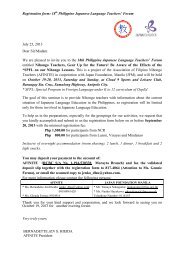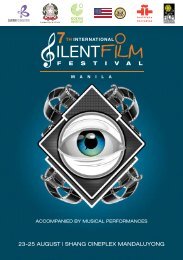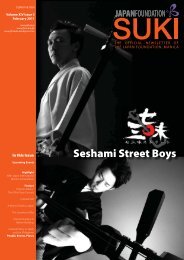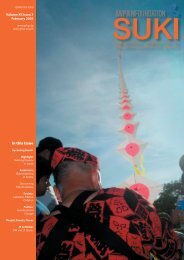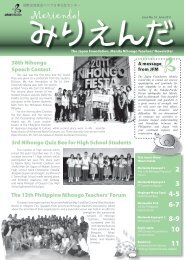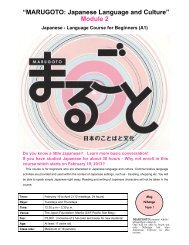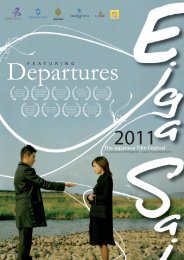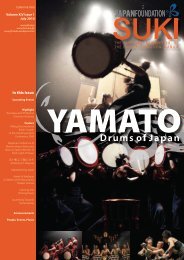In this Issue - The Japan Foundation, Manila
In this Issue - The Japan Foundation, Manila
In this Issue - The Japan Foundation, Manila
You also want an ePaper? Increase the reach of your titles
YUMPU automatically turns print PDFs into web optimized ePapers that Google loves.
10<br />
FEATURE<br />
<strong>The</strong> <strong>Japan</strong>-East Asia Network of Exchange for Students and Youths Programme (JENESYS) was<br />
launched by the Government of <strong>Japan</strong> as a result of the Second East Asia Summit (EAS) in January 2007<br />
during the term of former Prime Minister Shinzo Abe. It is a 35-billion-yen youth exchange program, inviting<br />
about 6,000 young people to <strong>Japan</strong> mainly from the EAS member states (ASEAN, Australia, China, <strong>In</strong>dia, New<br />
Zealand, the Republic of Korea) every year for five years with a view to establishing a basis of Asia’s stalwart<br />
solidarity by expanding youth exchange. <strong>The</strong> program is expected to deepen mutual understanding<br />
among young people who will assume important roles in the next generation in each East Asian country.<br />
Various kinds of exchange programs including inviting and dispatching youths have been implemented in<br />
cooperation with concerned countries and organizations.<br />
An Architect’s Perception<br />
from Travel to <strong>Japan</strong><br />
Text and Photo By<br />
Ramil B. Tibayan<br />
Travelling has been a hobby for me<br />
since I graduated from college. I have<br />
travelled the Philippines searching for the<br />
different architectural styles that the previous<br />
architects have used from the Spanish<br />
era up to the modern times. Travelling is<br />
also a way for me to learn the different<br />
customs and culture of the Philippines. I<br />
am an architect here in the Philippines and<br />
currently practicing my profession in the<br />
field of Construction Management and<br />
I am also an advocate of Philippine built<br />
heritage. When I was invited by the <strong>Japan</strong><br />
<strong>Foundation</strong> to visit <strong>Japan</strong>, I didn’t think twice<br />
about it. It is now my chance to see and learn<br />
the practices and methods that <strong>Japan</strong> is<br />
applying in preserving their heritage.<br />
Together with 25 delegates from East<br />
Asia and Pacific, we travelled <strong>Japan</strong> and<br />
stayed for 12 days to learn and experience<br />
their heritage and culture. Amazingly from<br />
these travels, it is good to see that <strong>Japan</strong>’s<br />
built heritages are exceptionally preserved.<br />
<strong>The</strong> temples of Kyoto, the machiya houses<br />
of Takayama, the Gassho-style houses of<br />
Shirakawa and the castle park of Kanazawa<br />
are some of the places we have visited that<br />
are all in good state of preservation. It is<br />
not only limited to built heritage but some<br />
customs and traditions of <strong>Japan</strong> are still in<br />
practice like the re-thatching of Gassho-style<br />
houses, the Owara dance and the traditional<br />
tea ceremony. <strong>In</strong> addition to these practices,<br />
we were also given the opportunity to have<br />
hands-on experience by participating in the<br />
pulling of the float at Kyoto’s Gion Festival.<br />
From my point of view, <strong>Japan</strong> has<br />
been successful in preserving their culture<br />
especially their built heritage. As I have<br />
observed through the lectures and site<br />
visits, there are 3 factors which led to <strong>Japan</strong>’s<br />
success in preserving and safeguarding their<br />
built heritage: community collaboration<br />
through the proper coordination of the<br />
local government units with the national<br />
government. Another factor is information<br />
drive. Through education, the local people<br />
have been educated with the importance<br />
of their heritage for the present and future<br />
generations. And lastly, patience is another<br />
key factor. Heritage preservation is not a<br />
short process, it takes time and thorough<br />
study to completely fulfil and realize a<br />
heritage preservation plan.<br />
Aside from the lectures and tours that<br />
opened me with the cultures and traditions<br />
of <strong>Japan</strong>, I also learned from the different<br />
perspectives of the 25 delegates that were<br />
invited to the program. Sharing insights<br />
and perspectives from different people<br />
with different cultures gave me the idea<br />
on their plans and point of views regarding<br />
heritage preservation. Though the delegates<br />
have different standpoints, we do share a<br />
common view that, “heritage is equally as<br />
important as a nation’s identity.” Without<br />
heritage, a nation has no identity. Heritage<br />
is something that we must be proud of. It<br />
is something that distinct us from other<br />
nations. That is why we need to take care<br />
of our own heritage and it must be passed<br />
on to the future generations. Although<br />
technological advancement and modernity<br />
has taken us, we must not forget our history<br />
and we should learn from it.<br />
Gassho style houses from Ainokura village<br />
the Owara dance<br />
detail from a float in Yatsuo Museum<br />
group workshop about<br />
Sannomachi area of Takayama<br />
eaves detail from a<br />
temple in Kyoto<br />
Kanazawa<br />
streetscape<br />
at chaya<br />
district<br />
mountain view from Ainokura village<br />
pulling of the float at Kyoto’s<br />
Gion Festival<br />
Ramil B. Tibayan is a licensed Architect, practicing in the field of Construction Management. An advocate of Philippine built heritage, he is a member of the Museum <strong>Foundation</strong> of the<br />
Philippines and the Heritage Conservation Society.



